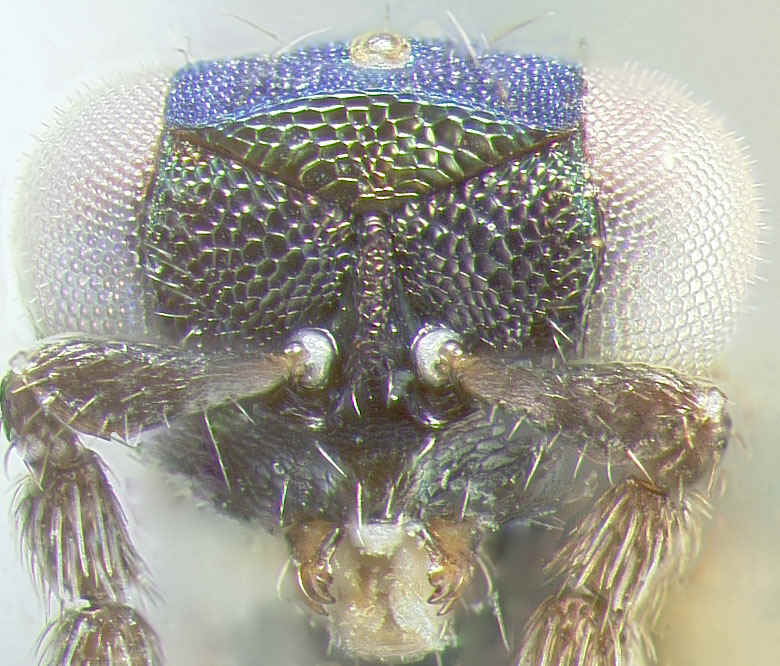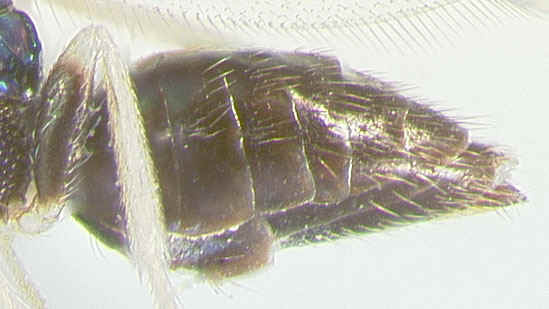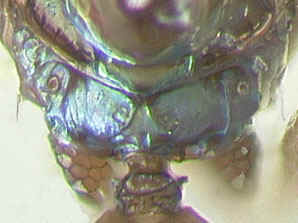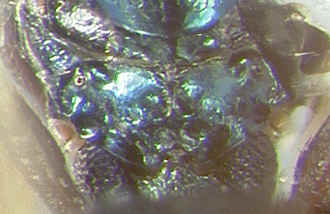

Proacrias face (left), and gaster of female (right)
return to: Eul 1 Eul 4 eud 1 eul 1 ent 1 ent 5 ent 10 ent 13 ent 16 ent 21 ent 26
Proacrias Ihering,
1914 comparative info return to: prev
home
Mandibular formula 3:3. Clypeus sometimes faintly outlined by sutures, usually
not discernable. Transverse frontal groove V-shaped; scrobal grooves reaching transverse
groove separately, usually extending below toruli ventrally; interscrobal process reaching
transverse groove. Vertex sometimes carinate. Flagellum 6-segmented, including 1 anellus.
Pronotal collar sometimes carinate; mesoscutal midlobe with 2 pairs of setae; anterior
portion of notauli curving sharply laterad; upper mesepisternum without an extension
overlapping posterior edge of prepectus; no pit between axilla and scutellum. Postmarginal
vein length variable: from shorter than stigmal vein to over 2x its length. Propodeum
with modified median carina: either broadened and dorsally flattened, or
split posteriorly; plicae sometimes present. Petiole transverse or longer than
broad, sometimes sculpted, sometimes with a dorsal flange. Compare with: Chrysocharis
(Zaommomyia), Pediobius, Neochrysocharis, Chrysocharis, Ionympha.


Proacrias face (left), and gaster of female (right)


Proacrias propodea
Biology: Proacrias coffeae has been reared from coffee leafminer, Leucoptera coffeella (Guérin-Méneville & Perrottet), Lyonetiidae. Other species have been reared from agromyzid leaf miners.
Comments: A poorly defined genus which may be misinterpreted because the type specimens of the type species, Proacrias coffeae Ihering, have been missing since at least 1969. Under the current interpretation, Proacrias is very similar to some Chrysocharis (Zaommomyia), to the point that I cannot confidently place some species to genus. It is also very similar to Pediobius and Closterocerus, from which it differs only in characters that are usually not used to define genera. I suspect that this Proacrias is closely related to Closterocerus, but not to Pediobius. This genus is chiefly Neotropical, but I have found it from Nearctic Mexico (Jalisco).
Comparative information:
Chrysocharis (Zaommomyia): Median carina of propodeum not broadened or posteriorly split.
Pediobius: First gastral tergite well-sclerotized and dorsal surface not collapsing or capable of changing shape when drying, the other tergites tending to telescope inside the first tergite in air-dried specimens; as opposed to the condition in Proacrias and similar genera (such as Closterocerus), where the gaster is dorsally collapsed in air-dried specimens and the first tergite does not hold a consistent shape. Upper mesepisternum with an extension that can usually be seen to overlap the posterior margin of the prepectus. First gastral sternite with a strongly sclerotized, densely punctulate region below the petiolar base.
Neochrysocharis: Median carina of propodeum not broadened or posteriorly split.
Chrysocharis s.s.: Scrobal grooves uniting before reaching transverse frontal groove.
Ionympha: Mandbiles elongate and with many small denticles. Gena with an incision for reception of mandibles. Ovipositor extremely short.
References:
Boucek, Z. 1977. Descriptions of two new species of Neotropical Eulophidae (Hymenoptera) of economic interest, with taxonomic notes on related species and genera. Bulletin of Entomological Research. 67(1): 1-15.
DeSantis, L. 1972. Chalcidoideos de Tierra del Fuego (Hymenoptera). in Anales de Primer Congresso Latinamerico de Entomología, Cusco, Peru, 12-18 de Abril 1971). Revista Peruana de Entomología. 15(1): 61-64.
Kerrich, G.J. 1969. Systematic studies on eulophid parasites (Hym., Chalcidoidea) mostly of coffee leaf-miners in Africa. Bulletin of Entomological Research. 59(2): 195-228.